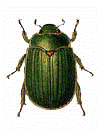Museum, University of Nebraska State
Date of this Version
10-1970
Abstract
Sappy wounds of injured or diseased trees entice a wide variety of insects. Carter (1945) stated that when fluxing is prolific or long continued, air-borne bacteria, yeasts, and fungi contaminate the oozing sap, ferment it and produce the material called slime flux. Apparently the oozing flux is toxic to the flux site and so prevents callusing by the tree. Consequently, the same tree usually can be a good collecting site for insects from year to year. My stay in Japan spanned four years, and collecting at flux sites was one of the most fruitful areas of endeavor. As soon as the vascular system of a tree became active in the spring the slime flux began to ooze out and attract insects. The best trees to visit were usually elms which possibly suffered from wetwood. April and May saw only a few insects feeding at the trees in the Tokyo area, but their numbers and kind greatly increased in June, July, and August; an abrupt decline in insect activity occurred in September.


Comments
Published in Entomological News 81 (1970), pp. 255-256.